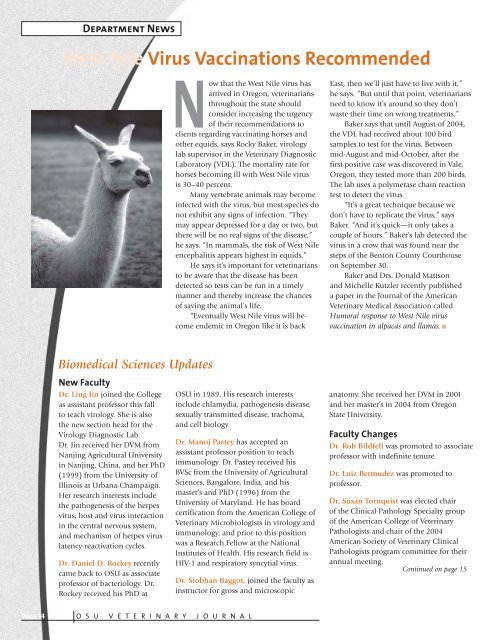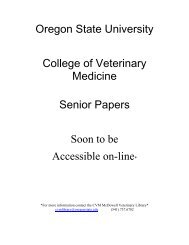W - College of Veterinary Medicine - Oregon State University
W - College of Veterinary Medicine - Oregon State University
W - College of Veterinary Medicine - Oregon State University
Create successful ePaper yourself
Turn your PDF publications into a flip-book with our unique Google optimized e-Paper software.
Department News<br />
West Nile Virus Vaccinations Recommended<br />
Biomedical Sciences Updates<br />
New Faculty<br />
Dr. Ling Jin joined the <strong>College</strong><br />
as assistant pr<strong>of</strong>essor this fall<br />
to teach virology. She is also<br />
the new section head for the<br />
Virology Diagnostic Lab.<br />
Dr. Jin received her DVM from<br />
Nanjing Agricultural <strong>University</strong><br />
in Nanjing, China, and her PhD<br />
(1999) from the <strong>University</strong> <strong>of</strong><br />
Illinois at Urbana-Champaign.<br />
Her research interests include<br />
the pathogenesis <strong>of</strong> the herpes<br />
virus, host and virus interaction<br />
in the central nervous system,<br />
and mechanism <strong>of</strong> herpes virus<br />
latency-reactivation cycles.<br />
Dr. Daniel D. Rockey recently<br />
came back to OSU as associate<br />
pr<strong>of</strong>essor <strong>of</strong> bacteriology. Dr.<br />
Rockey received his PhD at<br />
Now that the West Nile virus has<br />
arrived in <strong>Oregon</strong>, veterinarians<br />
throughout the state should<br />
consider increasing the urgency<br />
<strong>of</strong> their recommendations to<br />
clients regarding vaccinating horses and<br />
other equids, says Rocky Baker, virology<br />
lab supervisor in the <strong>Veterinary</strong> Diagnostic<br />
Laboratory (VDL). The mortality rate for<br />
horses becoming ill with West Nile virus<br />
is 30–40 percent.<br />
Many vertebrate animals may become<br />
infected with the virus, but most species do<br />
not exhibit any signs <strong>of</strong> infection. “They<br />
may appear depressed for a day or two, but<br />
there will be no real signs <strong>of</strong> the disease,”<br />
he says. “In mammals, the risk <strong>of</strong> West Nile<br />
encephalitis appears highest in equids.”<br />
He says it’s important for veterinarians<br />
to be aware that the disease has been<br />
detected so tests can be run in a timely<br />
manner and thereby increase the chances<br />
<strong>of</strong> saving the animal’s life.<br />
“Eventually West Nile virus will become<br />
endemic in <strong>Oregon</strong> like it is back<br />
OSU in 1989. His research interests<br />
include chlamydia, pathogenesis disease,<br />
sexually transmitted disease, trachoma,<br />
and cell biology.<br />
Dr. Manoj Pastey has accepted an<br />
assistant pr<strong>of</strong>essor position to teach<br />
immunology. Dr. Pastey received his<br />
BVSc from the <strong>University</strong> <strong>of</strong> Agricultural<br />
Sciences, Bangalore, India, and his<br />
master’s and PhD (1996) from the<br />
<strong>University</strong> <strong>of</strong> Maryland. He has board<br />
certification from the American <strong>College</strong> <strong>of</strong><br />
<strong>Veterinary</strong> Microbiologists in virology and<br />
immunology, and prior to this position<br />
was a Research Fellow at the National<br />
Institutes <strong>of</strong> Health. His research field is<br />
HIV-1 and respiratory syncytial virus.<br />
Dr. Siobhan Baggot, joined the faculty as<br />
instructor for gross and microscopic<br />
Page 14 O S U V E T E R I N A R Y J O U R N A L<br />
East, then we’ll just have to live with it,”<br />
he says. “But until that point, veterinarians<br />
need to know it’s around so they don’t<br />
waste their time on wrong treatments.”<br />
Baker says that until August <strong>of</strong> 2004,<br />
the VDL had received about 100 bird<br />
samples to test for the virus. Between<br />
mid-August and mid-October, after the<br />
first positive case was discovered in Vale,<br />
<strong>Oregon</strong>, they tested more than 200 birds.<br />
The lab uses a polymerase chain reaction<br />
test to detect the virus.<br />
“It’s a great technique because we<br />
don’t have to replicate the virus,” says<br />
Baker. “And it’s quick—it only takes a<br />
couple <strong>of</strong> hours.” Baker’s lab detected the<br />
virus in a crow that was found near the<br />
steps <strong>of</strong> the Benton County Courthouse<br />
on September 30.<br />
Baker and Drs. Donald Mattson<br />
and Michelle Kutzler recently published<br />
a paper in the Journal <strong>of</strong> the American<br />
<strong>Veterinary</strong> Medical Association called<br />
Humoral response to West Nile virus<br />
vaccination in alpacas and llamas.<br />
anatomy. She received her DVM in 2001<br />
and her master’s in 2004 from <strong>Oregon</strong><br />
<strong>State</strong> <strong>University</strong>.<br />
Faculty Changes<br />
Dr. Rob Bildfell was promoted to associate<br />
pr<strong>of</strong>essor with indefinite tenure.<br />
Dr. Luiz Bermudez was promoted to<br />
pr<strong>of</strong>essor.<br />
Dr. Susan Tornquist was elected chair<br />
<strong>of</strong> the Clinical Pathology Specialty group<br />
<strong>of</strong> the American <strong>College</strong> <strong>of</strong> <strong>Veterinary</strong><br />
Pathologists and chair <strong>of</strong> the 2004<br />
American Society <strong>of</strong> <strong>Veterinary</strong> Clinical<br />
Pathologists program committee for their<br />
annual meeting.<br />
Continued on page 15




